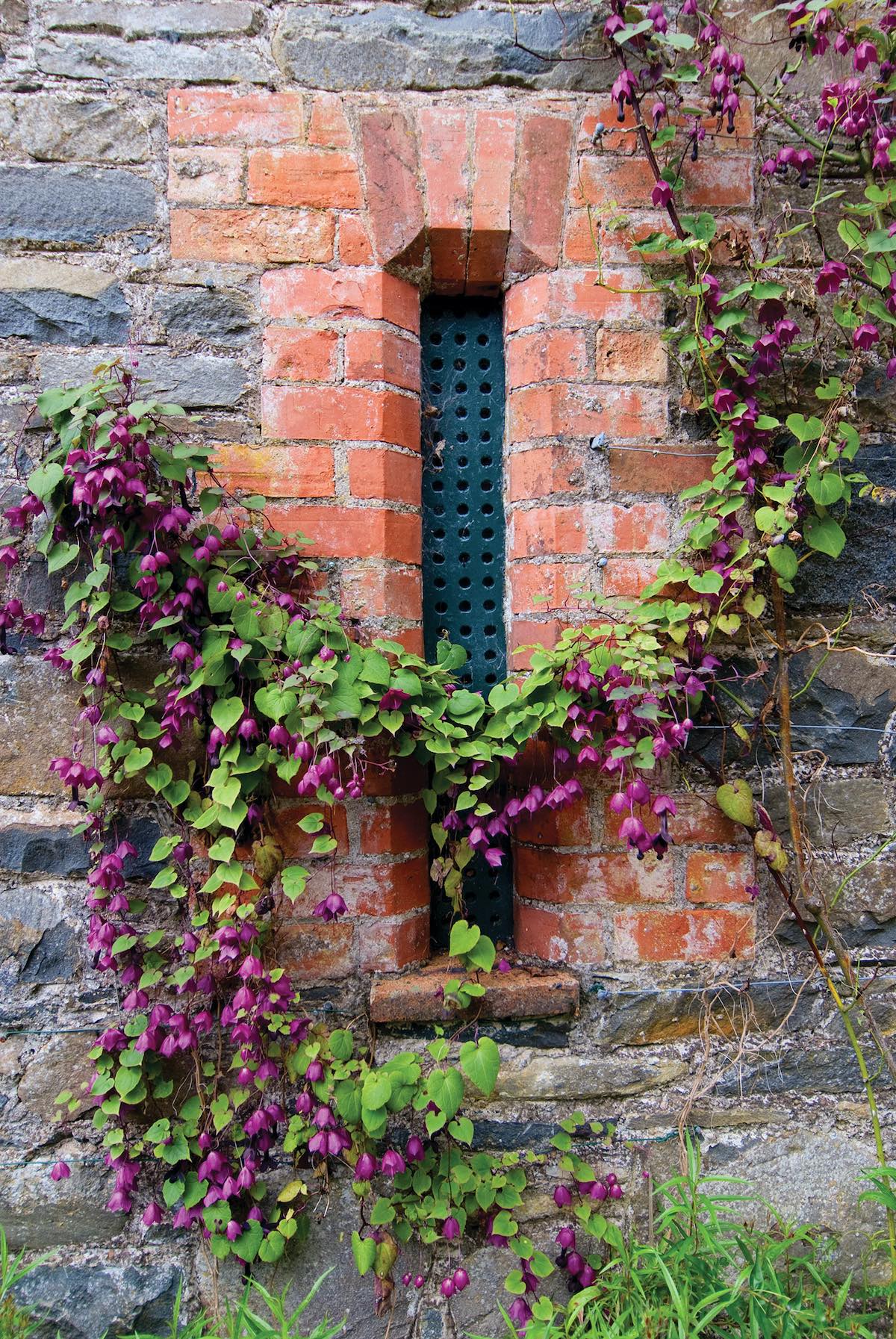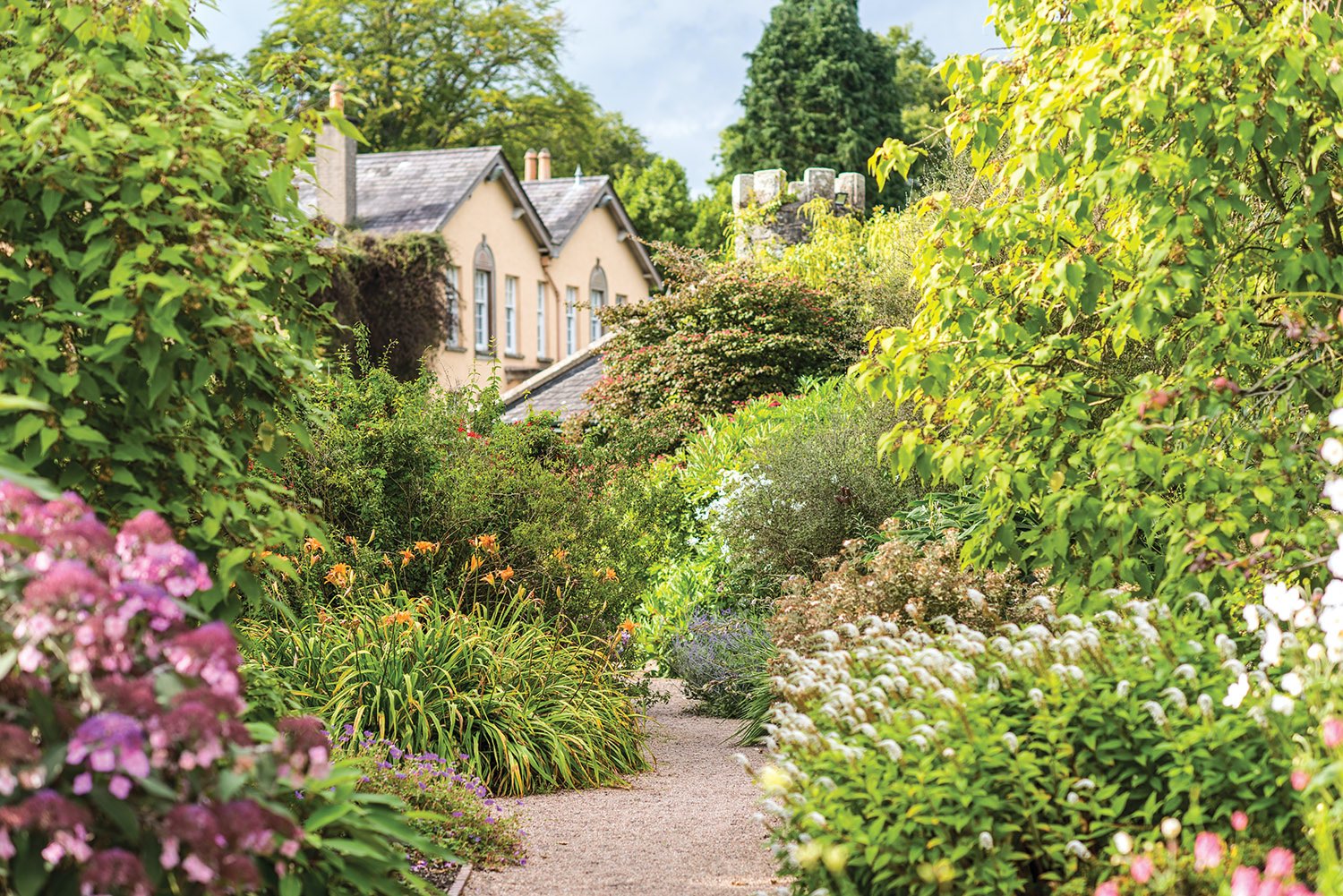
A Gothic bell tower, archway, and series of clipped sentinel yews mark the lane to the stable yard just past the house.
Long before you arrive at Rowallane, the multilayering of greens upon greens begins. The quintessential scenic countryside of Northern Ireland’s County Down, with its lush rolling hills and farmlands dotted by an occasional ancestral manor, seems to properly prepare you for the glorious vegetation to come. But what garden visitors find as a delightful surprise is the diversity behind the walls of Rowallane. First created in the mid-1800s, this horticultural hotbed is populated by an expansive array of plants, from perennials to shrubs to trees, that are given permission to play happily together. Formality is all but tossed to the wind—and that’s what makes it all the more beautiful.
Rowallane serves up 50-plus acres of exhilarating experiences. Most impressive are the massive, mature rhododendrons that stretch tall and wide. It was due to the strength of these immense shrubs that the National Trust chose to step in and take Rowallane under its wing. A 2-acre walled garden coddles a happy array of perennials and shrubs collected from hither and yon, many rubbing shoulders with a few comely vegetables. Only footsteps away, woodland paths send visitors journeying through seemingly wild plantings of English bluebells, primroses, ‘Pheasant’s Eye’ daffodils, and wood anemones that scamper through shady dells. The stony terrain nurtures rock garden plants that dote on superb drainage. In addition, there are numerous water features and pieces of statuary. And it’s all lovingly maintained with special attention given to the health and preferences of each green inhabitant. As Claire McNally, Rowallane’s head gardener, says, “Plants love it here. This is their perfect haven.”

Layers of agapanthus, Kniphofia, phlox, and roses soften the hydrangea-covered walled garden in a display that remains strong throughout the growing season.

Replenished annually, rhodochiton drape the stone walls in unique parachute-like flowers.
Rowallane has always followed the beat of its own drum with a naturalistic intent. When the Reverend John Moore bought the land in 1858, his family and friends were mystified by his attraction to a parcel of famished fields and poor grazing with an appalling quantity of stone underneath. But he had specific plans. Already keen on gardening, the Reverend built a house in 1860, again surprising everyone by going relatively modest with the abode while pouring most of the money into the parkland as he blasted rock to achieve a smooth approach to the house. Rather than hauling his boulder harvest away, he used the stone for walls and natural accents, such as whimsical stone chairs. He built a massive walled potager for practical purposes but elsewhere followed the influence of Irish-born journalist/gardener William Robinson by installing naturalistic plantings. And then the Reverend invited the public to come and witness his horticultural playground, specifically providing seats for his visitors’ comfort and viewing pleasure. It’s clear that this garden has a long history of sharing its charm.
Upon the Reverend Moore’s passing in 1903, his nephew, plantsman Hugh Armytage Moore, inherited the estate, adding more fascinating plants into the protected microclimate. The National Trust then took the estate under its care, stewarding the Victorian and Edwardian plantings while encouraging the public to partake in the beauty, which is particularly breathtaking when the rhododendrons are clad in their brilliant flower trusses.

The walled garden stacks a series of perennials such as daylilies and gooseneck loosestrife beside shrubs such as lacecap hydrangea and viburnums framing the walkway.

Corralled within a tidy clipped boxwood edging, quadrant beds are replanted annually.
All of the plantings are maintained by a team of five gardeners, plus a small army of volunteers. “They are so generous with their time and energy,” says Claire. “They truly love the garden and have an emotional connection with it.” Those team members serve as ready stewards for the Davidia involucrata, magnolias, rhododendrons, stewartias, and quantities of perennials that populate the farmland and former paddock. Adds Claire, “The views are panoramic. Everything surrounds you and sort of gives you a big hug. It all just feels magical.”

A dated brick arch fronted by Verbena bonariensis and Kirengeshoma provides a window on Eucryphia ‘Nymansay,’ an evergreen with honey-scented flowers.
“EVERYTHING SURROUNDS YOU AND SORT OF GIVES YOU A BIG HUG. IT ALL JUST FEELS MAGICAL.”

A softly-shaped, mature Magnolia stellata is surrounded by the stones that prevail at Rowallane. The boxwood-edged parterres have recently been replanted during a redesign.
A softly-shaped, mature Magnolia stellata is surrounded by the stones that prevail at Rowallane. The boxwood-edged parterres have recently been replanted during a redesign.
Planning a Visit
No need to master the tricky art of driving on the “wrong side of the street” in order to visit Rowallane. A bus can easily whisk you to its gates as part of a Belfast run. And Belfast is less than half an hour away with a variety of places to spend the night. Meanwhile, Rowallane plays the good host when you arrive, offering plenty of treats for the hungry traveler. The tea room serves sandwiches, as well as pastries and savory pies, to give you plenty of energy to walk the gardens.
Feel the urge to explore further? The market town of Saintfield is just minutes down the road with an array of antiquing opportunities. And then it’s just a short drive to several ultra-scenic sea towns, including Strangford, Killyleagh, Newcastle, and Portaferry.
Want even more bonding with nature? Pop into the tropical butterfly house at Seaforde Gardens while also taking a few minutes to walk its mature and lush hornbeam maze. For some architectural splendor, pay a call to the majestic Down Cathedral where St. Patrick is believed to lie buried. And throughout your journey, enjoy views of the Mourne Mountains that form a backdrop of breathtaking poetic beauty across the region.

In the herb and edible beds, tuteurs support miniature pumpkin ‘Baby Boo’ amid Agastache, perilla, thyme, and other herbs.
By Tovah Martin | Photography by Kindra Clineff



